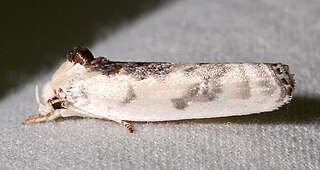
Edward Meyrick FRS was an English schoolmaster and amateur entomologist. He was an expert on microlepidoptera and some consider him one of the founders of modern microlepidoptera systematics.

The Lecithoceridae, or long-horned moths, are a family of small moths described by Simon Le Marchand in 1947. Although lecithocerids are found throughout the world, the great majority are found in the Indomalayan realm and the southern part of the Palaearctic realm.

The Archipini are a tribe of tortrix moths. Since many genera of these are not yet assigned to tribes, the genus list presented here is provisional.

Crambinae is a large subfamily of the lepidopteran family Crambidae, the crambid snout moths. It currently includes over 1,800 species worldwide. The larvae are root feeders or stem borers, mostly on grasses. A few species are pests of sod grasses, maize, sugar cane, rice, and other Poaceae. The monophyly of this group is supported by the structure of the tympanal organs and the phallus attached medially to the juxta.

Dichomeris is a genus of moths in the family Gelechiidae erected by Jacob Hübner in 1818.

Aphomia is a genus of small moths belonging to the family Pyralidae. Some breed in the nests of Anthophila, where their caterpillars are parasitic feeders of wax, honey and pollen.

Antaeotricha is a genus of moths. It is the largest genus in the subfamily Stenomatinae, numbering over 400 species in the Western Hemisphere.
Heteromicta myrmecophila is a species of snout moth in the genus Heteromicta. It was described by Alfred Jefferis Turner in 1913. It is found in Australia.
Heteromicta aegidia is a species of snout moth in the genus Heteromicta. It was described by Edward Meyrick in 1887 and is known from Australia.
Heteromicta alypeta is a species of snout moth in the genus Heteromicta. It was described by Turner in 1911, and is known from Queensland, Australia.
Heteromicta leucospila is a species of snout moth in the genus Heteromicta. It was described by Oswald Bertram Lower in 1907 and is known from Queensland, Australia.
Heteromicta ochraceella is a species of snout moth in the genus Heteromicta. It was described by Émile Louis Ragonot in 1901. It is found in Australia.
Heteromicta phloeomima is a species of snout moth in the genus Heteromicta. It was described by Alfred Jefferis Turner in 1911. It is found in northern Australia.
Heteromicta poeodes is a species of snout moth in the genus Heteromicta. It was described by Alfred Jefferis Turner in 1905. It is found in Australia.
Heteromicta poliostola is a species of snout moth in the genus Heteromicta. It was described by Alfred Jefferis Turner in 1904. It is found in Australia.
Heteromicta sordidella is a species of snout moth in the genus Heteromicta. It was described by Francis Walker in 1866. It is found in Australia.

Xyloryctidae is a family of moths contained within the superfamily Gelechioidea described by Edward Meyrick in 1890. Most genera are found in the Indo-Australian region. While many of these moths are tiny, some members of the family grow to a wingspan of up to 66 mm, making them giants among the micromoths.

Gelechiinae is a subfamily of moths in the family Gelechiidae. It was described by Henry Tibbats Stainton in 1854.

Stenoma is a genus of moths. The type species is Stenoma litura, which was described by Philipp Christoph Zeller in 1839.









